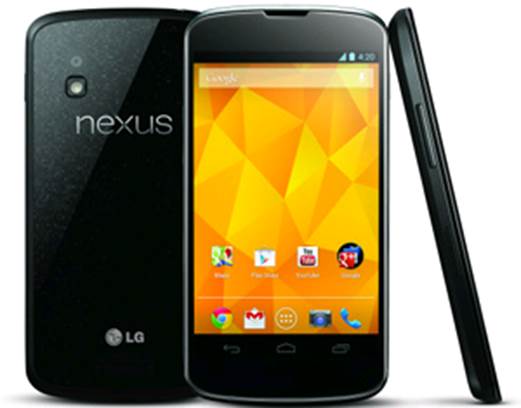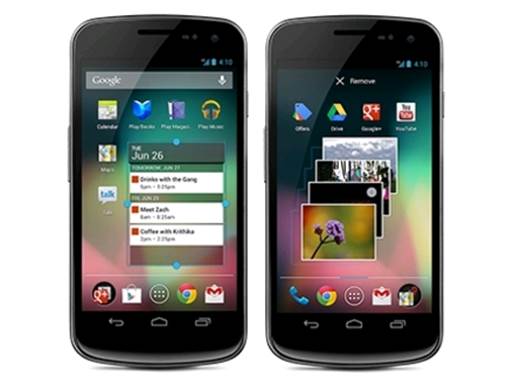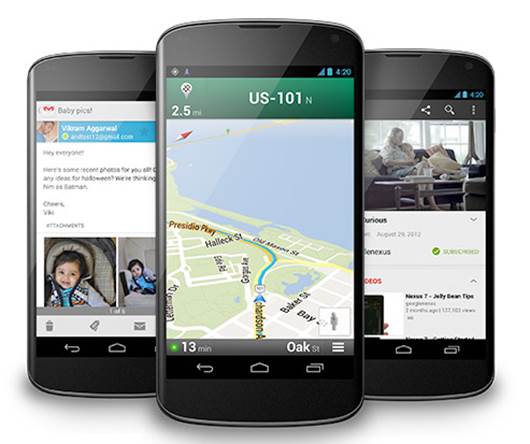After partnering with HTC and Samsung
for its smartphones, Google has now turned to LG for the Nexus 4. From the
front it looks similar to the previous Samsung Galaxy Nexus. It’s almost
exactly the same size, and suitably thin and light at 9.1mm and 139g.
It feels great in the hand, like a premium
smartphone. The black rear has a matrix of tiny silver dots, each reflecting
light at a different angle. The Nexus 4 comes to life as you move it.
Holographic screen or glitzy nail polish?

Google
Nexus 4
The build quality is nothing short of
exceptional. The Nexus 4 is the best-built Android smartphone we’ve seen in a
long time. The screen sits flush to the bezel, the micro-SIM tray slots in
perfectly, with no gaps, and the buttons have a smooth action. The battery is
fixed and there’s a micro-SIM tray on the side.
All this makes the $359 8GB SIM-free price
tag astonishing. The Nexus 4 is a game-changer, which allows consumers to get a
high-end smartphone at an affordable price, without suffering a long contract.
Performance
A Qualcomm Snapdragon S4 Pro quad-core
processor runs at 1.5GHz, and is paired with 2GB of memory. This specification
is impressive on paper, and the Nexus 4 lived up to our expectations in
benchmarks.
This Google handset set a new smartphone
record In Geekbench, with 2,009 points. This beats the iPhone 5, Samsung Galaxy
S III and Galaxy Note II, which scored 1,650, 1,659 and 1,958 respectively.
In JavaScript tests the Nexus 4 revealed
slower performance. We recorded 1,906ms in SunSpider, although web browsing
wasn’t noticeably slow.
The Nexus 4 matches the iPhone 5’s graphics
performance, and achieved a very good 39fps in GLBenchmark’s Egypt HD game.
The 4.7in screen offers 768x1280 pixels,
with a slightly lower pixel density than the iPhone 5, at 318-versus 326ppi.
The screen looks stunning, able to display excellent contrast, rich colours and
high levels of detail. The viewing angles are great, too, thanks to an IPS
panel.

The
4.7in screen offers 768x1280 pixels, with a slightly lower pixel density than
the iPhone 5, at 318-versus 326ppi.
Storage is a low point, with only 8- and
16GB versions available, and no expansion slot. Our 16GB sample had around 13GB
free space.
Connectivity options include dual-band
Wi-Fi (with support for Wi-Fi Direct), Bluetooth 4.0, NFC and wireless
charging. You can connect the handset to an external display through a SlimPort
HDMI adaptor. Missing is support for the UK’s 4G LTE offering from EE.
Buying a Nexus phone previously meant
having a so-so camera - not now. Colours look much more natural than from the
Galaxy Nexus camera, and the extra resolution makes a huge difference. This 8Mp
camera has an LED flash, too.
The camera app is speedy and easy to use.
New features include HDR mode and Photo Sphere. The latter enables you to take
360-degree panoramas.
A 1.3Mp front webcam provides a decent
image for video calls, with the usual graining on flat white objects, such as
walls and ceilings.
Software
An advantage of buying a Google- branded
handset is it’s guaranteed to be running the latest version of Android, while
it’s left up to the manufacturers of other smartphones to decide whether to
update their own software.
The Nexus 4 runs Android 4.2 Jelly Bean.
Not a great deal has changed since version 4.1, but there are a few notable
additions. Quick settings have been added to the notifications bar, providing
quick-access toggles for brightness, Bluetooth, flight mode and more.

The
Nexus 4 runs Android 4.2 Jelly Bean.
You can now place widgets on the lock
screen for quick access to key information such as messages, emails and
calendar. And, by default, you can access the camera app by swiping left. This
is a nice idea, but if you use a security PIN or lock pattern then anyone who
picks up your phone can see the widgets you’ve selected.
More cards have been added to Google’s
psychic. Now search engine, including package tracking and film information,
while Daydream mode can display content such as photos when the Nexus 4 is
docked or charging. Other changes include a new clock Interface and an extra
column in the app menu.
The best improvement is to the keyboard.
There’s less need to install a third-party keyboard for gesture typing - you
can key in a word simply by dragging one finger around the keyboard, drawing a
line through the characters required. It takes a while to get used to, and
requires both hands to hold the smartphone, but allows for much faster typing.
The Nexus 4 has a large 7.8Wh battery. We
got through a whole day, with enough juice left over for the next day. Gaming
or video will drain the battery faster. Lighter users might even see two days’
use.
|
Details
·
Price: $359 inc VAT
·
Contact: www.play.google.com
Specification
·
1.5GHz Qualcomm Snapdragon S4 Pro (ARM
quad-core)
·
Google Android 4.2 Jelly Bean
·
2GB RAM
·
8GB/16GB flash storage
·
4.7in (768x1280, 318ppi) IPS touchscreen
·
Adreno 320 graphics
·
802.11b/g/n (dual-band with Wi-Fi Direct)
·
Bluetooth 4.0
·
GSM 850/900/1,800/1,900MHz
·
WCDMA 850/900/1,700/1,900/2,100MHz
·
Micro-SIM
·
GPS
·
8Mp rear camera with LED flash
·
1.3Mp front-facing camera
·
1920x1080 video
·
3.5mm headset jack
·
Micro-USB
·
NFC
·
Wireless charging
·
7.8Wh lithium polymer, non-removable battery
·
69x134x9.1 mm
·
139g
Verdict
·
Provided the storage capacity will suffice,
the Nexus 4 is the definition of a bargain. You get the performance and
features of a high-end smartphone for half the price you’d expect to pay.
Unless you’re set on an iPhone, the Nexus 4 is unbeatable.
·
Build: 4.5/5
·
Features: 4/5
·
Performance: 4.5/5
·
Value: 5/5
·
Overall: 4.5/5
|